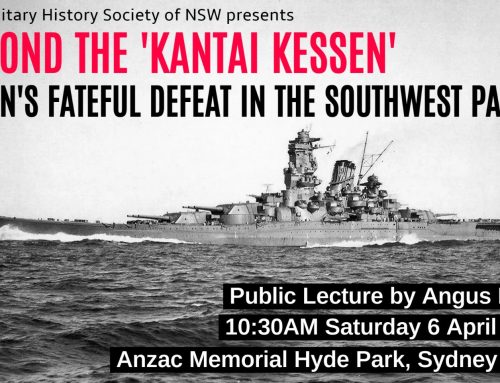The Singapore Strategy: A Century of Warning
A Public Lecture by Angus Britts

October 2023 marks the one-hundredth anniversary of the introduction of the Singapore strategy at the 1923 Imperial Conference in London. This scheme, which involved the construction of a major naval base at Singapore as its centrepiece, became the keystone for Australia’s continental defence until the fall of Singapore on 15 February 1942, and the subsequent enforced withdrawal of the British Eastern Fleet from the eastern Indian Ocean on 8 April of the same year.
This lecture seeks to illustrate the progression of the strategy following its gestation in 1919 through the course of the interwar period, the opening twenty-eight months of the Second World War prior to Japan’s entry in December 1941, and the subsequent events noted above. Principal areas of attention include the construction of the original strategy and its alterations from 1923-41, the establishment of the naval base in the 1930s with Australian reactions to the scheme within the same period, the fighting condition of the Royal Navy as of the outbreak of the European war in 1939, and the effects of the European conflict on Singapore’s defence before the commencement of the Japanese offensive. Post 8 December 1941, attention shifts to the opening six days of the Malayan campaign which ultimately determined the fate of Singapore itself, and the events which gave rise to the retirement of the Eastern Fleet. Extending the effects of the Singapore strategy on Australia’s defence includes this latter episode through its ongoing attachment to the main purpose of the original scheme: to meet and defeat the Japanese at sea.
Accompanying these various e
nquiries is an assessment of the impact of the strategy on Australian defence and foreign policy in the post-war era, extending to the present situation with AUKUS and China. It is with this objective in mind that the title for the address has been chosen, for though the strategy itself is long gone, a number of its core themes are recognisable within the formulation of Australia’s defence capabilities and alliance structures to this day
About the Presenter
Angus Britts is an Australian historian who resides in Sydney. He graduated with a postgraduate Research Masters from the University of Sydney and his major area of historical interest is British imperial naval defense and the Singapore strategy. Angus’s books on this theme include Neglected Skies: The Demise of British Naval Power in the Far East 1922–42 (2017) which covers a wide period of history that takes the British Navy from the heights of its might to the point of near decay at a critical time, A Ceaseless Watch: Australia’s Third Party Naval Defense 1919–1942 (2021) which illustrates how Australia confronted the need to base its post–World War I defense planning around the security provided by a major naval power, and Ikara: Australia’s Cold War Wonder Weapon (2021), for the Naval Historical Society of Australia, which sets the scene for the development of the Ikara missile via a description of anti-submarine warfare during the Second World War and the evolving Cold War situation with Russian submarine developments.





